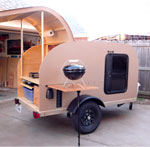caseydog wrote:Why would a large tire necessarily be stronger than a smaller tire?
I don't know if "stronger" is the ideal term, but any given part of the tread of a larger tire will be in ground contact less frequently, and thus have less of a heat buildup problem - heat is the big killer of tires.
Also, comparing two tires of the same sidewall height and section width, the one on the larger wheel (and correspondingly larger outside diameter) will be less severly distorted (there's that heat production and stress again) by conforming to the road to form the same contact patch than the one on the smaller wheel. It also has a better approach to bumps than the little tire - compare hitting a bump with a mountain bike tire tire to the same bump with a wheelbarrow tire.
caseydog wrote:When it comes to a tire coming apart, I'd be more concerned about the manufacturer, the age, inflation and the maintenance of a tire, when it comes to a potential for failure.
I agree that these are all important, but given two tires of the same manufacturer and model, of the same age, condition, and inflation pressure, the larger tire will have more ability to safely and reliably carry load.
caseydog wrote:Actually, those small tires are "trailer spec" tires, which means they are rated to carry more weight than the trailers they support are rated to carry. They have sturdier sidewalls than a passenger car tire.
The tires on any axle (trailer or motor vehicle) must have at least enough capacity to meet the axle rating; that means that on a trailer the tires must always be rated to carry at the least the weight carried on the axle, which in turn is typically 90% of the weight of the trailer... there's nothing special about the "trailer spec" tires in this respect.
In practice, most trailers are supplied with tires which are rated to barely carry the trailer on which they are mounted, and then only when inflated to exactly the ideal pressure and never run at high speed. They have at best 10% more margin than a passenger car tire from their rated capacity to what they can really stand without failure, which is why passenger car tires are generally permitted by the manufacturer to be used for trucks, vans, and trailers, as long as you "derate" them by 10% (e.g. if the published capacity is 1000 lb for use on a car, you can use it on a trailer for loads up to 900 lb).
Special Trailer (ST) spec tires are designed for a higher load in the same size than a passenger (P) tire, but mostly due to higher inflation pressure. The stronger sidewall construction is simply a function of the design pressure. My car and van both run on tires which happen to be built to XL (extra load) spec, rather than SL (standard load) - just because that's the only way this particular model of tire is available - and so they have 51 PSI inflation pressure, two-ply sidewalls, and high load capacity... just like a Load Range C trailer (or Light Truck, or commercial) tire.
If you could buy car tires in XL form in tiny sizes, they would be nearly identical to the trailer tires.... but cars here don't come so small that this size of tire would be useful, and cars (and light trucks and vans) typically use tires which are larger and run at lower pressures, for better ride and handling. If you look at a compact truck with a 3500 lb rear axle capacity and the trailer it is towing, also with a 3500 lb axle capacity, the truck most likely has wider and taller tires, running at lower pressure. The trailer tires are not better - they are the smallest and therefore cheapest available choice. In big commercial trucks where the tractor and trailer are operating under the same requirements, they typically use the same size and construction of tire to carry the same load... not big tires on the tractor axles and tiny tires on the equally loaded trailer axles.



